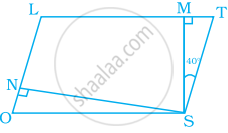Advertisements
Advertisements
Question
Ratio of consecutive angles of a quadrilateral is 1 : 2 : 3 : 4. Find the measure of its each angle. Write, with reason, what type of a quadrilateral it is.
Solution
Suppose PQRS is a quadrilateral.

Let m∠P : m∠Q : m∠R : m∠S = 1 : 2 : 3 : 4
So, m∠P = k, m∠Q = 2k, m∠R = 3k and m∠S = 4k, where k is some constant
Now,
m∠P + m∠Q + m∠R + m∠S = 360°
∴ k + 2k + 3k + 4k = 360°
⇒ 10k = 360°
⇒ k = 36°
∴ m∠P = 36°
m∠Q = 2k = 2 × 36° = 72°
m∠R = 3k = 3 × 36° = 108°
m∠S = 4k = 4 × 36° = 144°
Now, m∠P + m∠S = 36° + 144° = 180°
We know if two lines are intersected by a transversal such that the sum of interior angles on the same transversal is supplementary, then the two lines are parallel.
∴ Side PQ || Side SR
Also, m∠P + m∠Q = 36° + 72° = 108° ≠ 180°
So, side PS is not parallel to side QR.
In quadrilateral PQRS, only one pair of opposite sides is parallel. Therefore, quadrilateral PQRS is a trapezium.
RELATED QUESTIONS
Perimeter of a parallelogram is 150 cm. One of its sides is greater than the other side by 25 cm. Find the lengths of all sides.
If the ratio of measures of two adjacent angles of a parallelogram is 1 : 2, find the measures of all angles of the parallelogram.
In the adjacent figure, if seg AB || seg PQ, seg AB ≅ seg PQ, seg AC || seg PR, seg AC ≅ seg PR then prove that, seg BC || seg QR and seg BC ≅ seg QR.

In parallelogram ABCD, ∠A = 3 times ∠B. Find all the angles of the parallelogram. In the same parallelogram, if AB = 5x – 7 and CD = 3x +1 ; find the length of CD.
ABCD is a parallelogram. What kind of quadrilateral is it if: AC = BD but AC is not perpendicular to BD?
In parallelogram ABCD, E is the mid-point of AD and F is the mid-point of BC. Prove that BFDE is a parallelogram.
In parallelogram LOST, SN ⊥ OL and SM ⊥ LT. Find ∠STM, ∠SON and ∠NSM.

In parallelogram MODE, the bisector of ∠M and ∠O meet at Q, find the measure of ∠MQO.
The angle between the two altitudes of a parallelogram through the vertex of an obtuse angle of the parallelogram is 45°. Find the angles of the parallelogram.
Construct a parallelogram ABCD in which AB = 4 cm, BC = 5 cm and ∠B = 60°.
